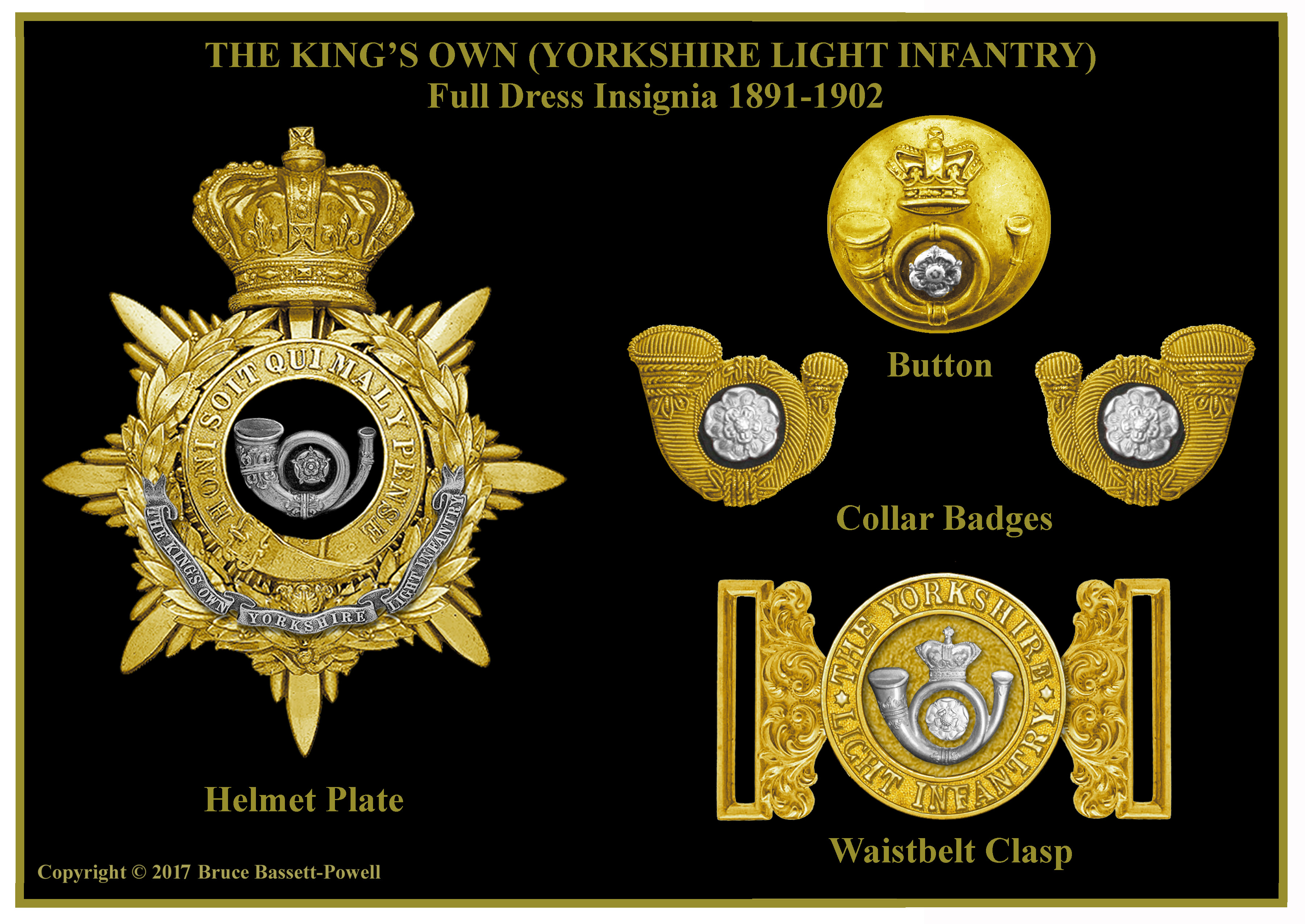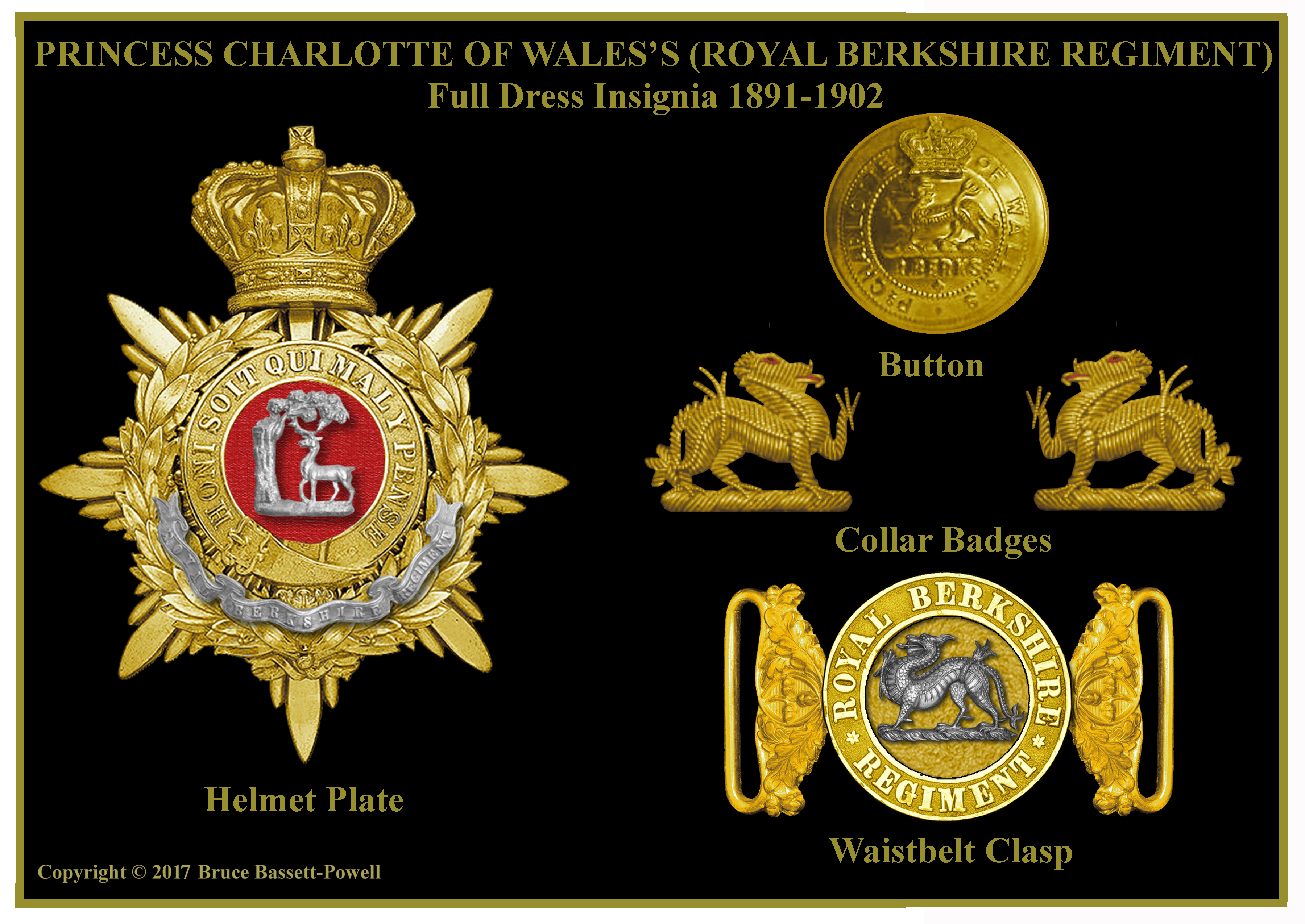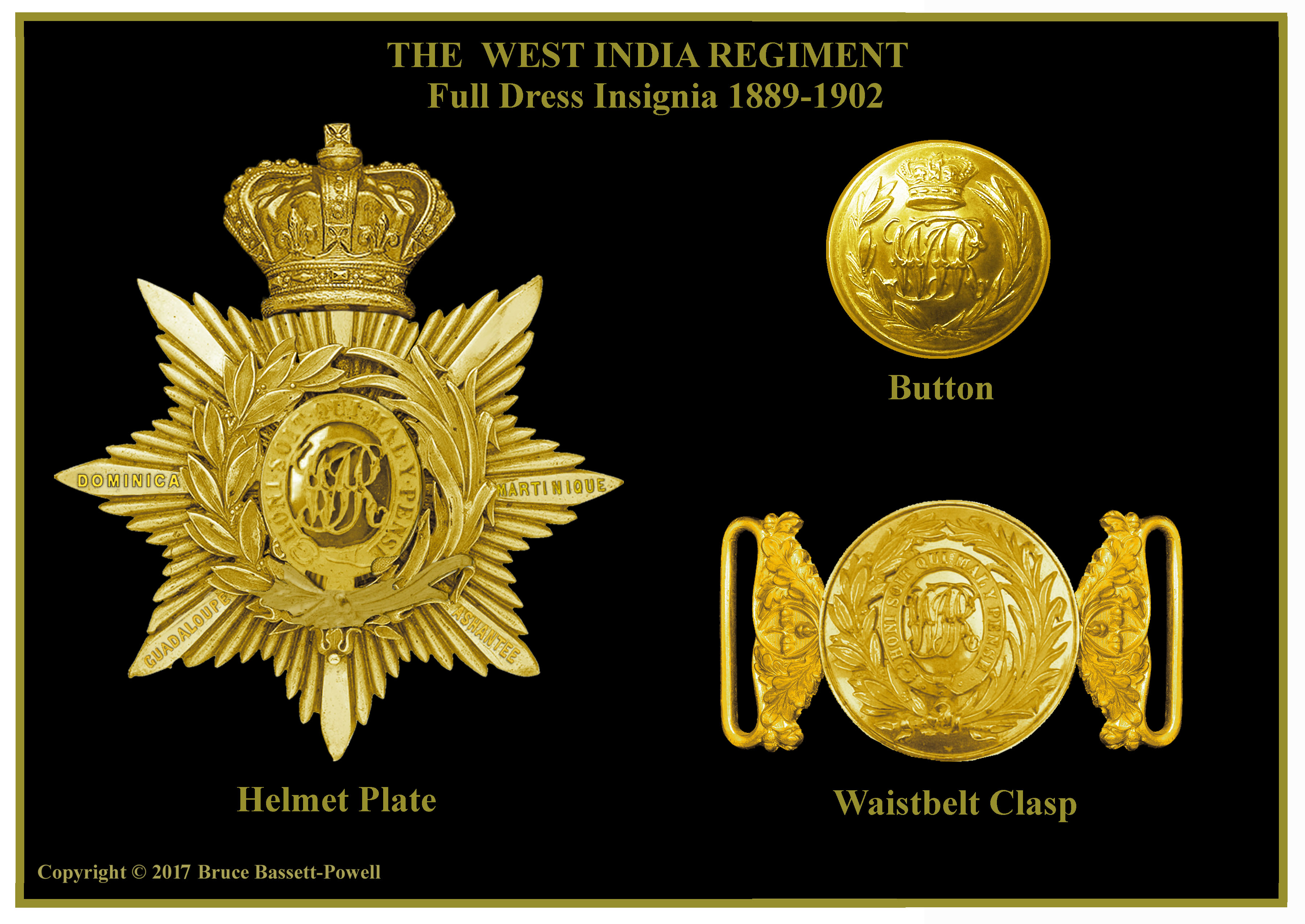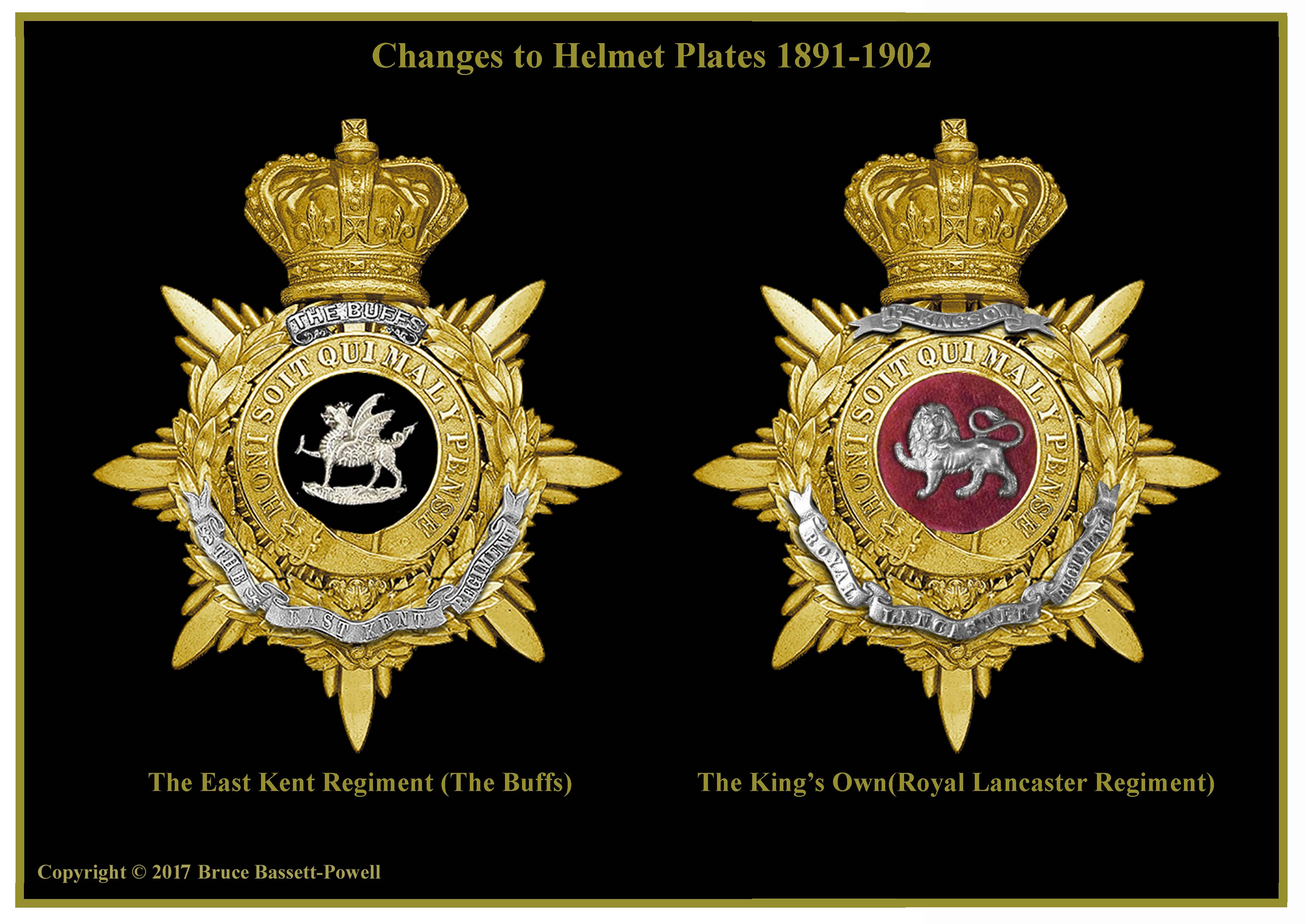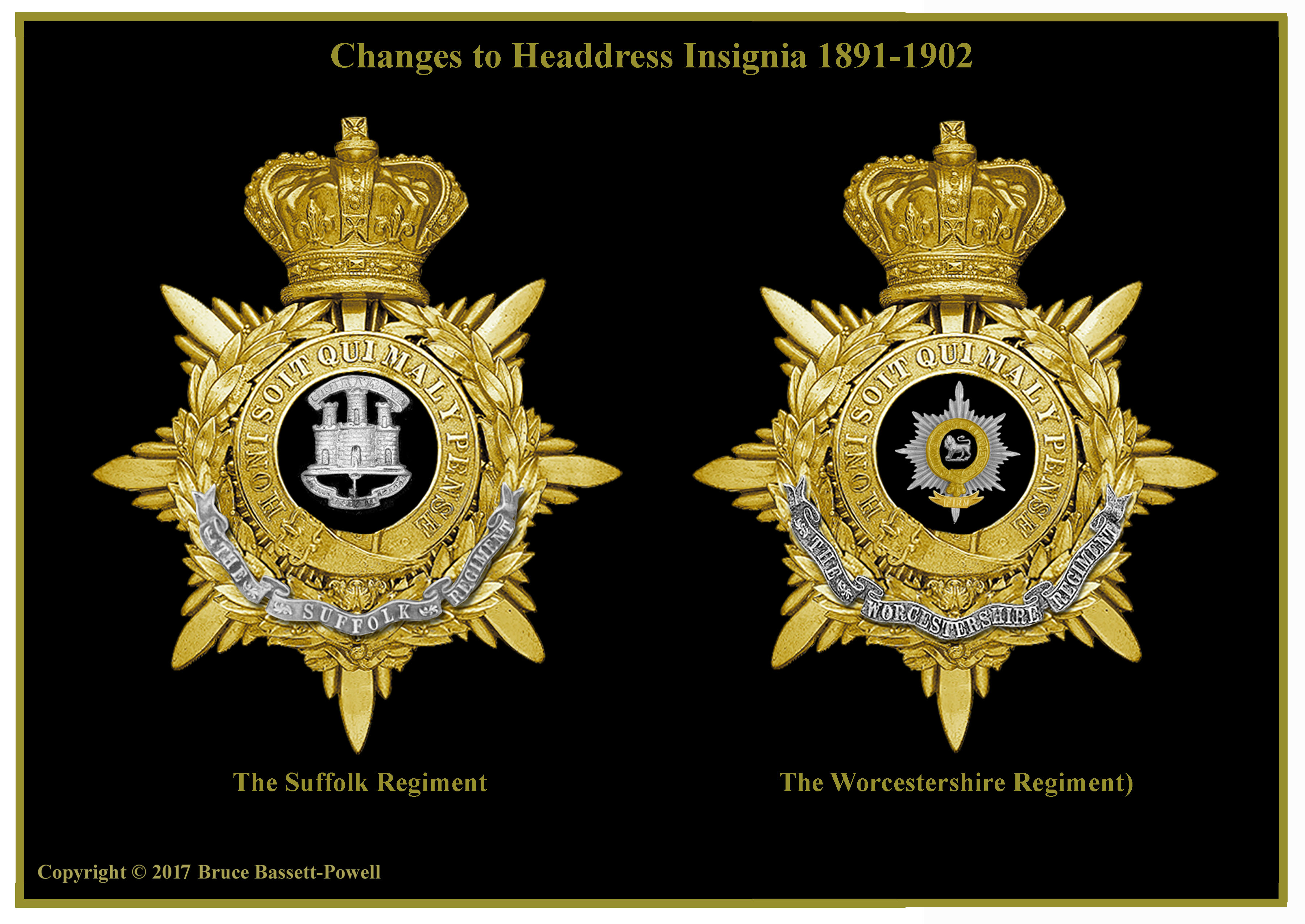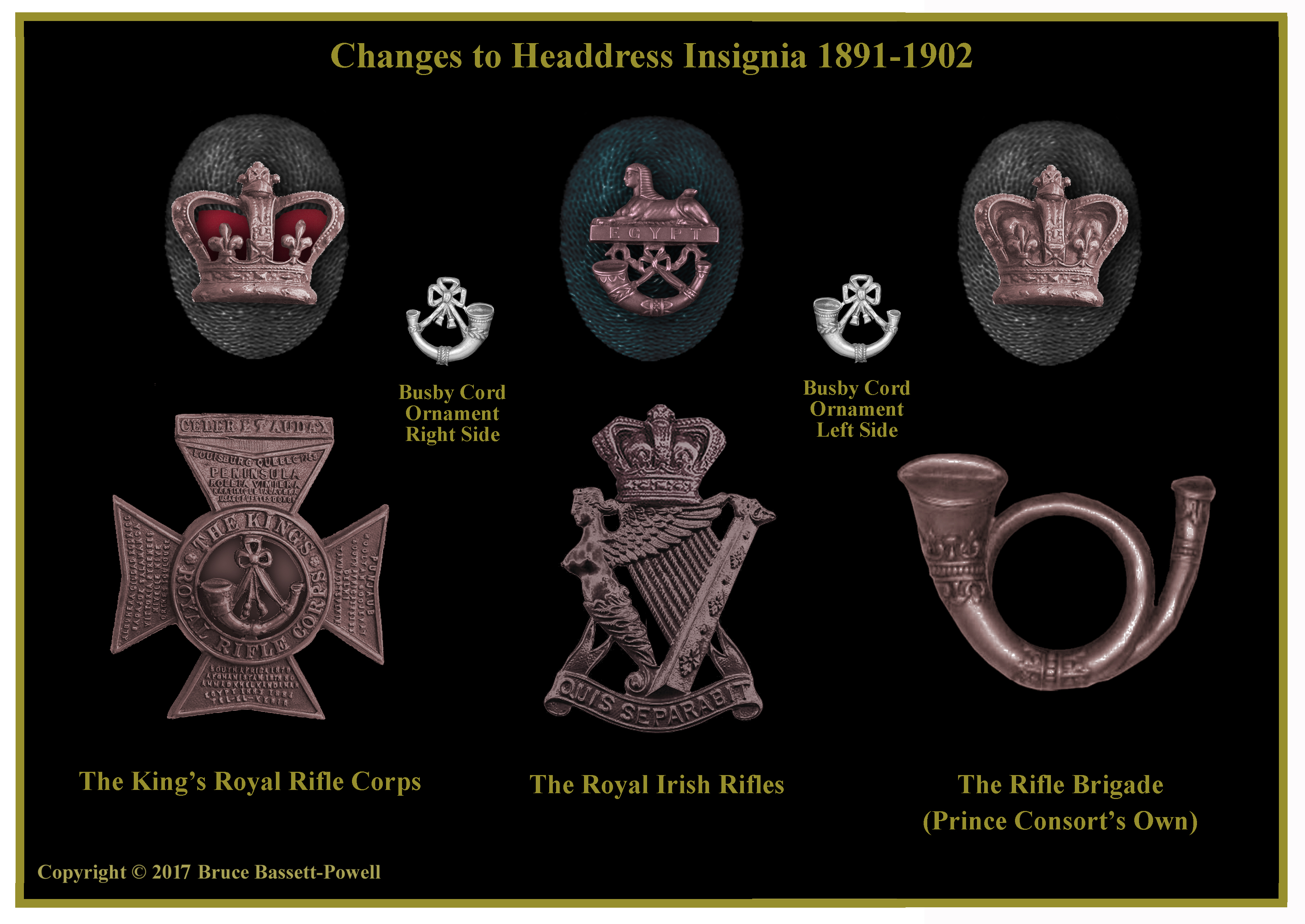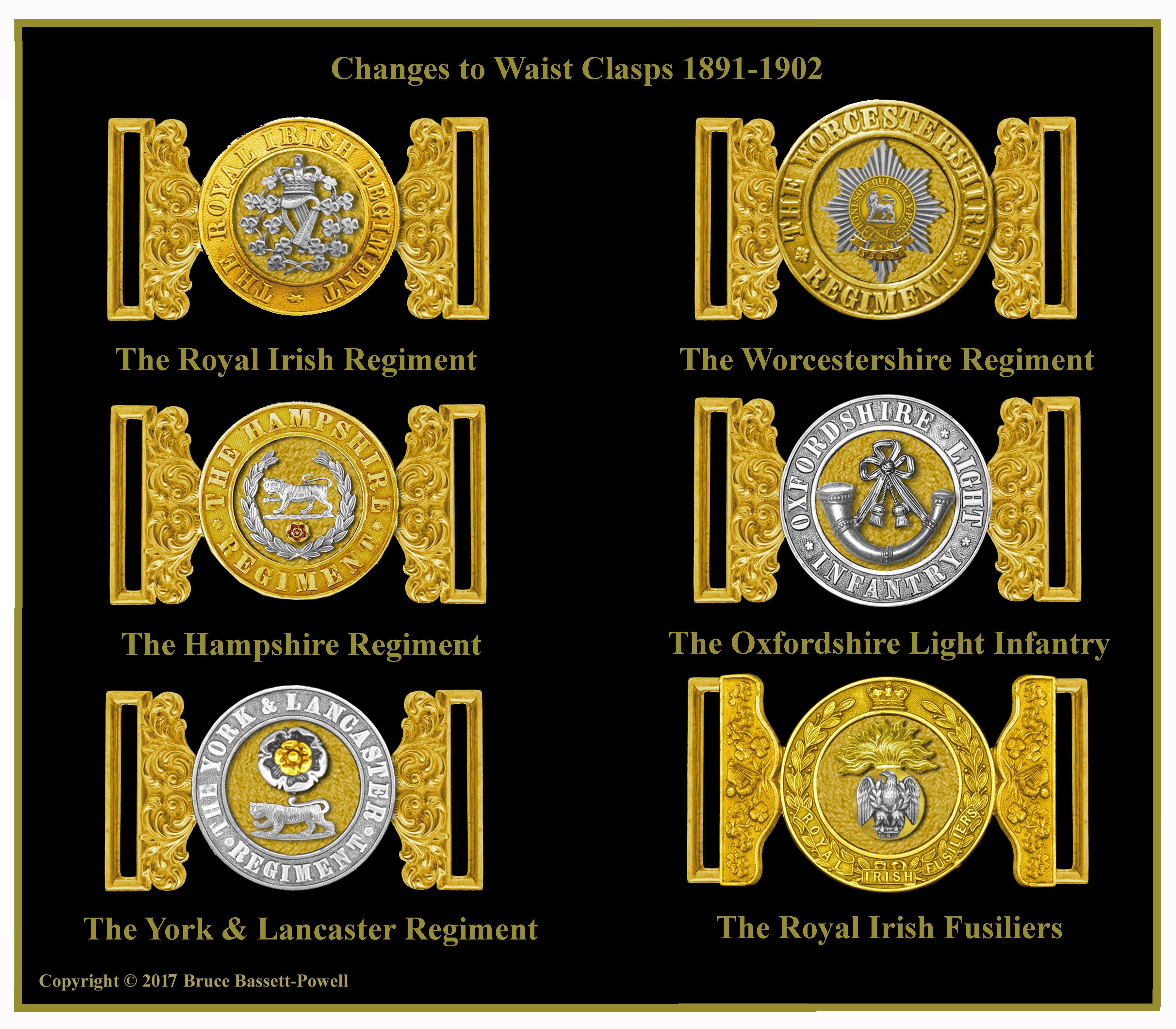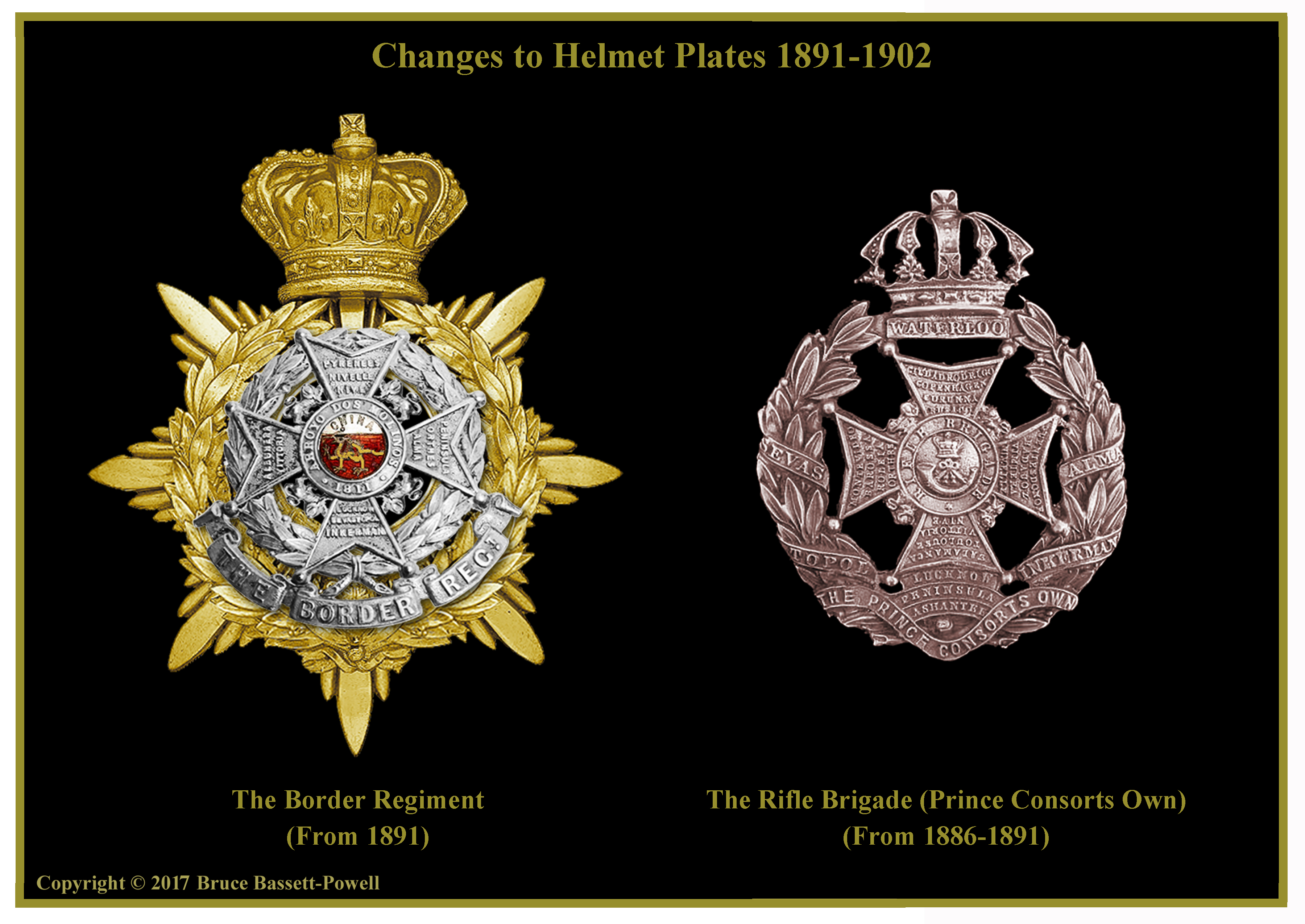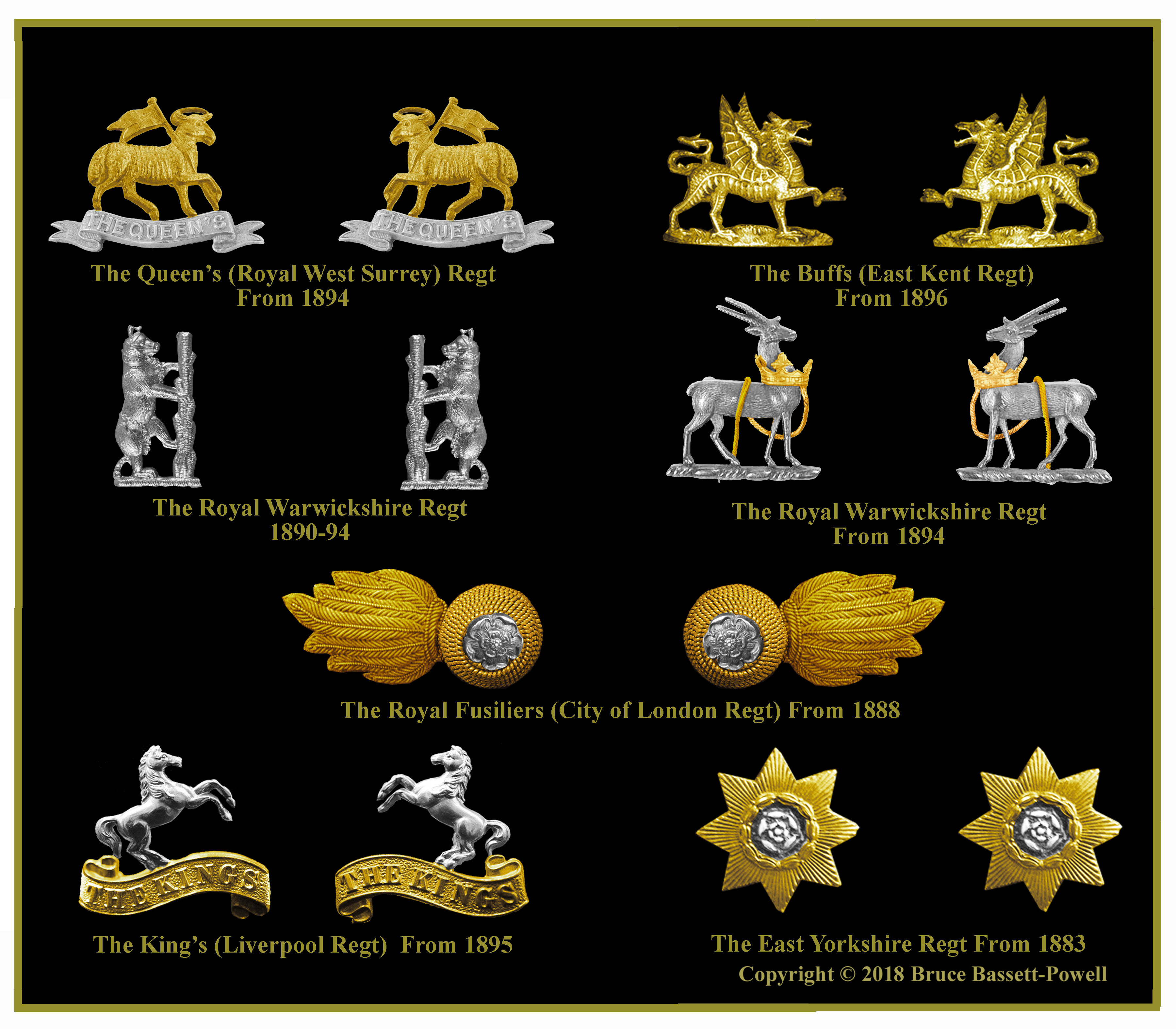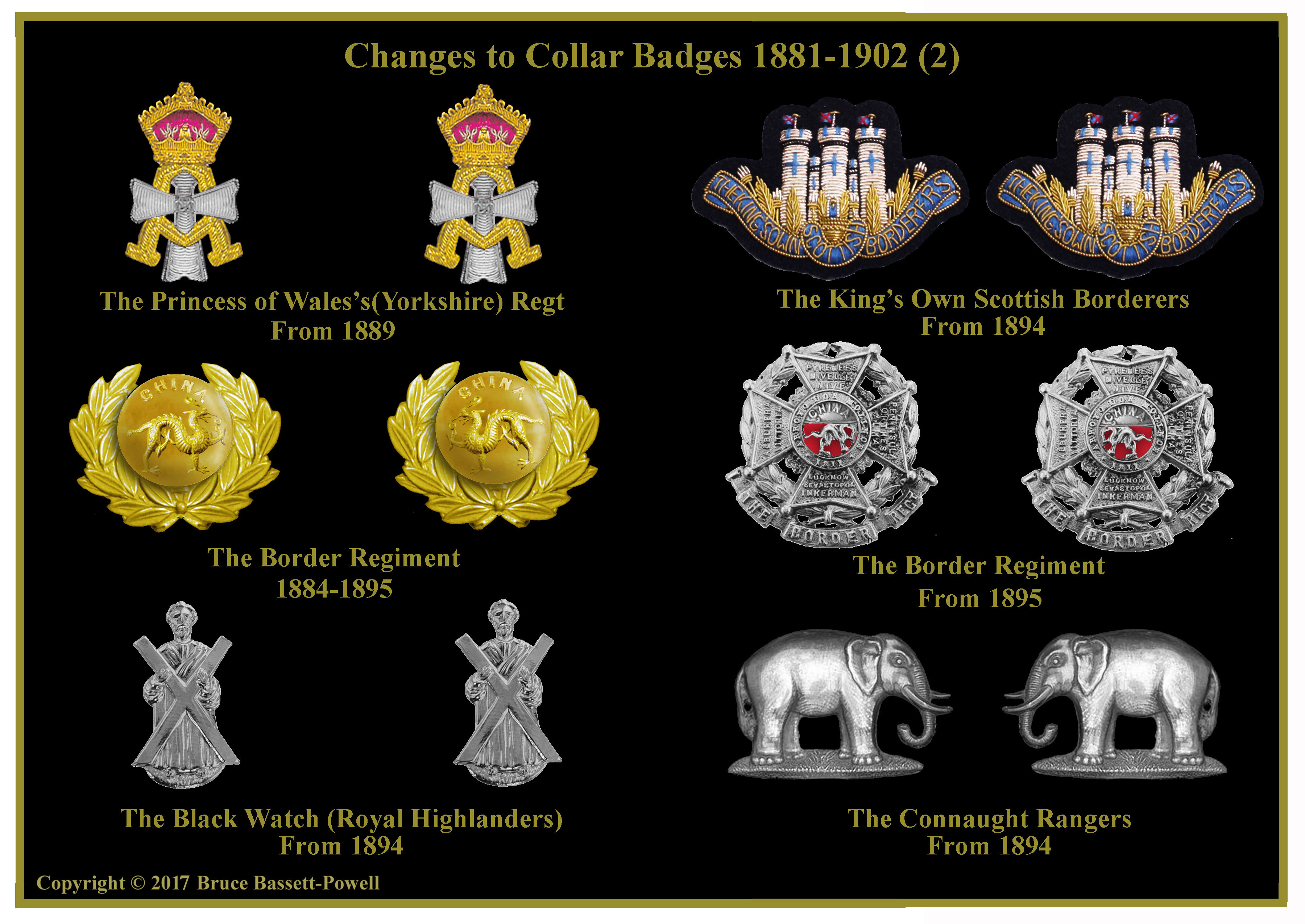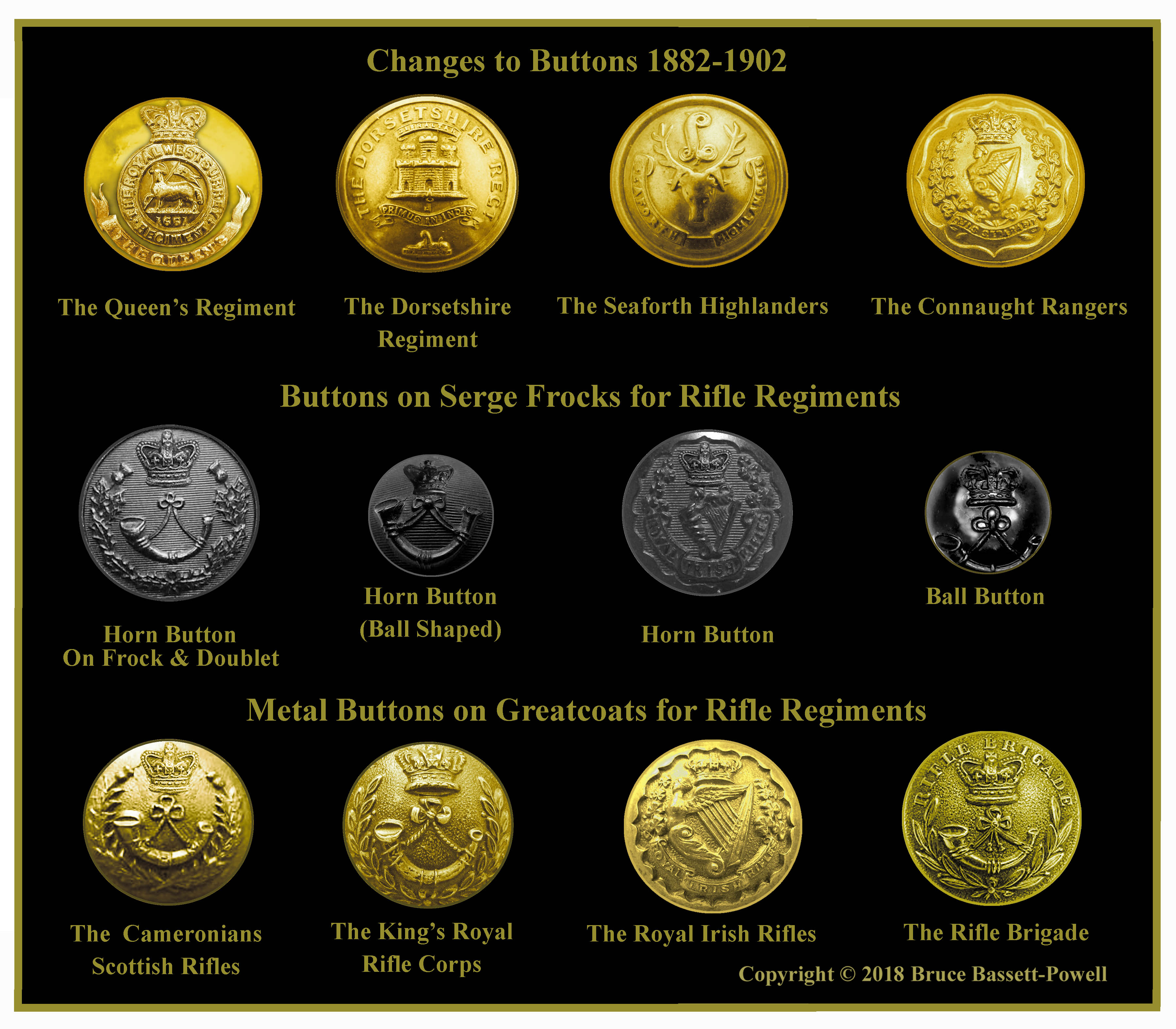APPENDIX
PART 2
INSIGNIA VARIATIONS BETWEEN 1881 AND 1902
The creation of the new, so-called 'Territorial' infantry regiments under the Cardwell and Childers Reforms over a relatively short period, had necessarily led to some compromises and hasty decisions. When selecting new insignia for the regiments created by merger between the Militia and Regulars of the hitherto sequentially numbered line, there were inevitably some units who saw themselves as having lost out with some element of their much prized and separate lineage. In the years that followed attitudes gradually settled and, as the new identities developed, some prejudices and strong feelings came to the surface and led to change. Some regiments had embraced the input and influence of the former Militia, so that the symbols that they had brought to the union became very much a part of the unit identity. The roses of Yorkshire and Lancashire are a prevalent example of this. In some cases former Militia badges were dropped, a good example being the Royal Warwickshire Regiment, who perhaps resting on the dignity of their time-honoured lineage as the former 6th Regiment of the Line, decided that they preferred their ancient Antelope insignia over the chained bear of the Neville Family and so changed their collar badge. In other cases, such as that of the York and Lancaster Regiment, successors of one of the two previously numbered regiments felt that their previous collar badge had been insufficiently respected, and so to the Bengal Tiger collar badge of the old 65th was added the combined red and white rose of the old 84th York and Lancaster. In this way the two battalions, 1st and 2nd, each felt that their history was equally valued and represented within their conjoined insignia. Other examples of change were much more subtle and items as small as buttons might be changed to a minute degree. Good examples being the senior regiment of England, the Queen’s Royal (West Surrey) Regiment, who wishing their longevity to be emphasized added the date 1661 to an otherwise almost identical button, or the Seaforth Highlanders, who thinking the stag on their button looked more like a cow, replaced the image with a more slender variety. Some other changes were brought about simply by change of regimental title either, to add the approbation of ‘Royal’ as a prefix, or to reflect a change in wording so that the Territorial association appeared in sequence before the name of a Royal personage whose title graced the regiment’s identity. Finally in 1901, the old Queen Victoria died and Edward VII came to the throne. This led to the adoption of a new and so-called Tudor crown to signify his reign, so that over the succeeding year all insignia was changed to reflect this.
Please Note: As many of you know, the study of British badges and insignia can be complicated. We strive to ensure accuracy every day. Any time we find an error we do correct it on the site, so if you have seen a mistake in the past, check the page again as we have probably corrected it.
Page 8
The Princess Charlotte of Wales's (Royal Berkshire Regiment). In recognition of the gallantry of the 1st Battalion at Tofrek in 1885, the regiment was granted the title "ROYAL". Because the 1st Battalion remained overseas for some time, the change of insignia did not take place until 1891. Most of the insignia remained the same except for the title scroll on the helmet plate, the scarlet backing to the badge and the addition of "Royal" on the waist clasp circle.
The button was also changesd slightly with an "R" before "BERKS" beneath the dragon. The collar badges remained unchanged.
The King's Own (Yorkshire Light Infantry). On 1st June 1887, the regiment's title was changed from the King's Own Light Infantry (South Yorkshire Regiment) to the title it would retain until amalgamation in the 1960s. The regiment was not happy with its insignia and petitioned for some changes which received the Queen's signature. The Badge on the helmet plate was simplified along with the badge on the waist clasp. The full title of the regiment was now on the helmet plate scroll and the waist clasp circle bore "The Yorkshire Light Infantry". The button was also changed adding a silver rose in the centre of the bugle. The only change to the collar badges was the replacement of the roses in silver embroidery to ones of silver metal.
The following regiments made changes to most of their full dress insignia between 1883 and 1902.
The WE BEGIN WITH THE CHANGES OF INSIGNIA BY THE ENGLISH, WELSH AND IRISH REGIMENTS. THE MAJOR CHANGES IN THE SCOTTISH REGIMENTS WILL FOLLOW.
The West India Regiment. The two West India Regiments were amalgamated in 1888 to form two battalions. The immediate changes were not obvious. The 2nd battalion, which had yellow facings still had them in 1896 and it is possible that the changes in insignia were also not quick to change. By 1898 both battalions had adopted them.
The East Kent Regiment (The Buffs). In 1900 A scroll with the word “THE BUFFS” was added above the garter and below the crown.
The King’s Own (Royal Lancaster Regiment) In 1900 A scroll with the word “THE KING’S OWN” was added above the garter and below the crown. In addition, the ground in the centre was changed to crimson velvet.
The Suffolk Regiment. In 1900, the Castle and Key were redesigned to conform to War Office instructions.
The Worcester Regiment. The design in the centre was changed to a silver eight pointed star in 1891. On the star, in gilt metal, the Garter with motto. Within the Garter, the Lion in silver on a black velvet ground. Below the Garter a scroll in gilt inscribed “Firm”.
The following regiments made changes to their Headdress Insignia.
All the Rifle Regiments changed their helmets for busbies in 1891. The black Persian lambskin busby of a size and shape now familiar to all, had black silk plaited cords in front with two cords behind. The cords were secured on the sides with two small bronze bugles, which later became silver. Above the badge was an oval black cord boss which in the Royal Irish Rifles was dark green. The badges were as follows;
King’s Royal Rifle Corps. The Maltese Cross in Bronze metal. Above this a tablet inscribed “Celer Et Audax” On the Cross, the battle honours of the regiment. On the black boss above a bronze crown with crimson cap.
The Royal Irish Rifles. The Harp surmounted by the Crown in Bronze. On the scroll the legend “Quis Seperabit”. On the boss the Sphinx over Egypt; below a stringed bugle.
The Rifle Brigade (Price Consort’s Own). A bronze bugle horn. Above, on the boss, a bronze crown.
----------------------------------------------------
There were several minor changes made to some regiments insignia before 1902 that do not warrant a specific image but are descibed below.
The following regiments had “Regt.” Changed to “Regiment” on their universal scrolls. The actual dates are not certain but all before 1902.
East Yorkshire Regiment, The East Surrey Regiment, The Sussex Regiment, The Hampshire Regiment and the Middlesex Regiment.
The following regiments had the Castle and Key redesigned in accordance with War Office Instructions in 1900. The new castle was similar in style to the one shown in the Suffolk Regiment Plate;
The Dorsetshire Regiment, The Essex Regiment and The Northamptonshire Regiment.
The coronet on The Prince of Wales’s Plume worn by the Cheshire Regiment and the Leinster Regiment were altered to gilt or gilding metal before 1900.
----------------------------------------------------
The following regiments made changes to their Waist Clasps
The Royal Irish Regiment. By 1900, The harp and crown had been reduced in size and the shamrock wreath increased.
The Worcestershire Regiment. A few minor changes had taken place after 1881, but in 1890 the centre of the clasp was redesigned to conform to the helmet plate.
The Hampshire Regiment. before 1900, the silver wreath had been reuced in size and open at the top, while the tiger and wreath were also reduced.
The Oxfordshire Light Infantry. In 1893 the title was slightly changed on the circlet and the decorations on the bugle simplified.
The York and Lancaster Regiment . "THE" was added to the title on the circlet sometime after 1895 while in the centre, the tiger was reduced and the rose enlarged.
The Royal Irish Fusiliers. Changes were made to the waist clasp as early as 1882 and by the next year the now gilt circlet showed a wreath with a crown above and on three small scrolls below "ROYAL IRISH FUSILIERS"
----------------------------------------------------
The 1902 changes in dress regulations abolished the sword belt with waist clasp and replaced it with a waist sash underneath which was a plain canvas swordbelt.
There are a very few examples of the waist belt clasp with the Edward VII crown, among them the King's Own Yorkshire Light Infantry and the Connaught Rangers, but they could have only been worn for a short time.
----------------------------------------------------
WAIST CLASPS
There were very few changes to waist plates between 1881 and 1902. Some regiments followed the example of the change in title on the helmet plate scroll by adding a "THE" or changing "REGT" to "REGIMENT" but that was the extent of it. The six regiments shown below had changes that were also quite minor (except for the Worcester Regiment) but significant enough to illustrate.
----------------------------------------------------
The Border Regiment. Even though the 1881 badge was itself unique, it was again changed in 1891 to reflect changes in other insignia. This distinctive would remain in use as long as the cloth helmet was worn.
The Rifle Brigade. In 1885 the star on the 1878 badge was removed and the Maltese Cross within the wreath surmounted by a Guelphic crown in bronze was adopted.
CHANGES TO COLLAR BADGES 1881-1902
Of all the insignia changes that took place before 1902, the collar badge became the most numerous of them. The reasons are not difficult to understand: When the regiments were amalgamated in 1881, an effort was made to include Militia badges, many of ancient lineage. However, as regimental identity began to settle on the regular battalions, the influence of the militia faded. Many regiments petitioned to have their insignia reflect long held devices not originally included. From the 1890s onward it became more common for headdress and collar devices to be the same and this often translated into the insignia chosen for the 1895 field service cap.
Not all collar badges were changed because of the reasons stated above and some changes were simply for modification. Exact details of how the changes came about are beyond the scope of this study and the plates below reflect the names, descriptions and date changes of the regiments only.
The Queen’s Regiment. 1898: Gilt Metal Lamb on Torse changed to Gilt Metal Lamb on white metal curved scroll inscribed “THE QUEENS”
The Buffs. 1894: White Metal Prancing Horse of Kent on gilt scroll inscribed “INVICTA” changed to Gilt Metal Dragon on ground with widespread wings. In 1898 the Dragon was changed to silver.
Royal Warwickshire Regt. 1890: White Metal sitting Bear changed to Bear Standart and ragged staff. 1894: Changed to White Metal Chained Antelope.
Royal Fusiliers. 1888: Changed from gold bullion Grenade to Grenade with silver Rose on the ball.
King’s Regiment (Liverpool). 1896: Rose in red and green enamel on scroll inscribed “KINGS” changed to White Metal prancing horse on Gilt Metal scroll inscribed "THE KING'S“.
East Yorkshire Regiment. 1883: Gold bullion star with silver rose changed to Gilt Metal star with silver star on black enamel backing.
Yorkshire Regt. 1882 Cypher and separate gold bullion coronet with silver bullion cross edged red changed to one piece badge. Changed 1889 to badge with smaller coronet. 1899: Date of “1875” inscribed on cross.
King’s Own Borderers. 1894 Gold bullion Edinburgh Castle with coloured scrolls changed to silver bullion Edinburgh Castle with coloured threads and scrolls bearing regimental title.
Border Regt. 1884: Laurel wreath in silver with Gilt Metal China Dragon above a scroll inscribed “CHINA” on a convex white and red enamel ground changed to Gilt Metal laurel wreath on burnished convex ground with the Dragon and CHINA inscribed on the dome. 1895: The badge essentially the same as on the helmet plate.
The Black Watch. 1894: Bare legged White Metal St. Andrew with cross changed to fully robed St. Andrew with cross.
Connaught Rangers. 1894: Elephant in silver bullion with blue velvet caparison edged gold changed to White Metal elephant without caparison.
COMING NEXT:
CHANGES IN BUTTONS
BUTTON VARIATIONS BY REGIMENT FROM 1881 TO 1902
Unlike soldiers of infantry regiments, who had ceased to wear regimental buttons in 1872, the officers' buttons had gone from elegant simplicity before 1881, to often quite complex designs, as regimental committees tried to devise new buttons that successfully combined the iconography of militia regiments and regular battalions that in many cases had hitherto had entirely separate histories and honours. In the years that followed this merger of units, a few regiments altered their design for a range of reasons and this section will predominantly cover the changes that took place and also cover the introduction of regimental buttons to the four rifle regiments created in 1881.
Queen's (Royal West Surrey Regiment). The Queen's, the senior line regiment of England, added the date of their formation, 1661, immediately below the famous lamb that had long been the emblem of their linear forebears, the 2nd (Queen's) Regiment of Foot.
The Dorsetshire Regiment. In 1900, along with all other regiments whose insignia incorporated an image of the fortress of Gibraltar, were ordered by Headquarters Horse Guards to adopt a standardised design with three towers.
(The Northamptonshire Regiment also had to change their buttons accordingly)
The Seaforth Highlanders. The Seaforth Highlanders had been dissatisfied with the design of a stag's head that had been utilised for their button as it had been described as too much like the head of a cow and at a date unknown this was changed to a head of more realistic and attractive proportions.
The Connaught Rangers. In 1894 the Connaught Rangers opted to change the button incorporating the elephant and tiger of the old 88th and 94th Regiments of Foot to a more recognisably Irish design of a crowned harp within a wreath of shamrock that also pleased the four regiments of militia that had been included in the make up of the new regiment.
The Northumberland Fusiliers and the Norfolk Regiment both had regimental mottos on a girdle and for a short time used a similar design, but with the motto on a garter.
The Rifle Regiments
In addition to the two long standing rifle regiments, the King's Royal Rifle Corps and the Rifle Brigade, two new regiments were formed in 1881, the Cameronians (Scottish Rifles) and the Royal Irish Rifles, both of which had some light infantry lineage within their heritage. All four regiments wore special, rifle pattern tunics, that utilised netted buttons and olivets, so regimental buttons were confined to just greatcoats and undress garments such as the frock.
The Cameronians (Scottish Rifles). On greatcoats a so called 'pebbled' metal button was worn incorporating a crowned thistle wreath enclosing a stringed horn. On other undress garments a bone button of similar design, but with a horizontally ribbed backing was worn.
The Kings Royal Rifle Corps. On greatcoats a 'pebbled' metal button was worn incorporating a crowned laurel wreath enclosing a stringed horn. On other undress garments a bone, ball shaped button of a more simple design without the wreath and with a horizontally ribbed backing was worn.
The Royal Irish Rifles. On greatcoats a 'pebbled' metal button was worn, but with a so-called scalloped rim incorporating a crowned Irish harp and scrolls bearing the regimental title beneath, each flanked by sprigs of shamrock. On other undress garments a bone button of similar design, but with a horizontally ribbed backing was worn.
The Rifle Brigade. On greatcoats a 'pebbled' metal button was worn incorporating a crowned laurel wreath enclosing a stringed horn surmounted with the regimental title in full. On other, undress garments a metal, ball shaped button of a more simple design without the wreath and similar to that used by the Kings Royal Rifle Corps was worn.
Go To
THE SPECIAL BADGES AND INSIGNIA OF
SCOTTISH REGIMENTS 1891-1902





